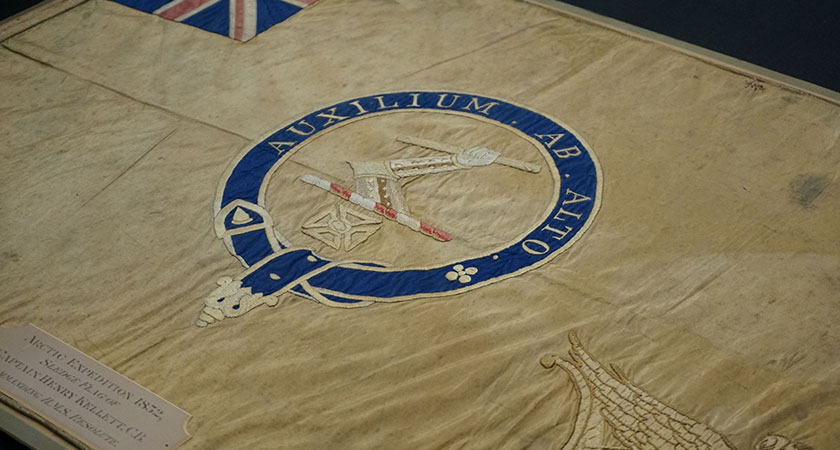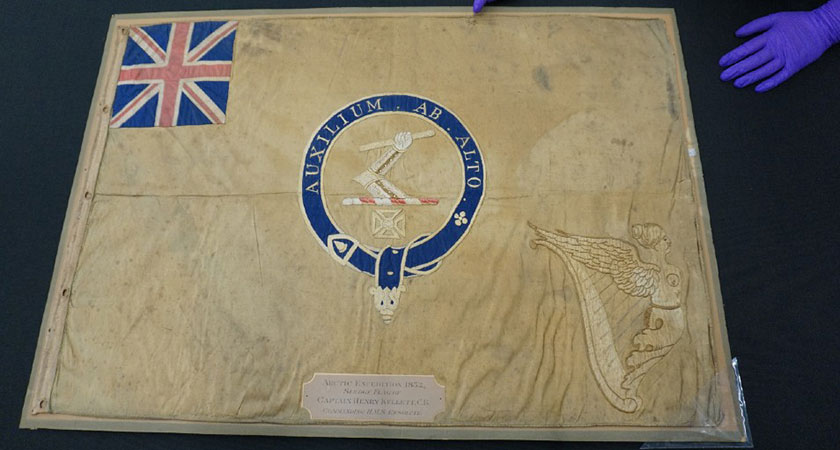A SLEDGE flag that once belonged to explorer and 'proud Irishman' Henry Kellett has been bought by the National Museum of the Royal Navy (NMRN).
In March, the museum launched a bid to raise £120,000 to buy the flag to ensure it stayed in Britain rather than fall into the hands of a private collector.
The flag was owned by Vice-Admiral Kellett from Co. Tipperary and was flown during his 1852 expedition to find the lost ships of Captain John Franklin — HMS Erebus and HMS Terror.
Featuring details representing his Irish heritage, Kellett's flag is now set to go on display at various locations, including Belfast.
'Courage and fortitude'
"Vice-Admiral Sir Henry Kellett's sledge flag and Franklin's expedition represent courage and fortitude in the face of adversity — core elements of our national identity that echo through our history," said Professor Dominic Tweddle, Director General of the NMRN.
"They also reflect the British and global obsession with finding and navigating the Northwest Passage, as well as the Royal Navy's role in expedition and exploration from Captain Cook to Darwin and HMS Beagle, to HMS Challenger in 1872, and continuing today with HMS Protector — the ice patrol ship in Antarctica and the Southern Hemisphere.
"The Kellett flag will be displayed in Belfast, Hartlepool and Portsmouth as part of an exhibition featuring artefacts from Erebus that are being transferred to the National Museum of the Royal Navy by Canada National Parks.
"The National Museum is proud to have stepped forward to save the Kellett flag from being exported overseas and to continue our work linking navy to nation."
Irish detailing
The sledge flag was made from silk in a rich green colour with an Irish harp embroidered in golden thread, all to reflect Captain Kellett's Irish heritage.
It also features the Kellett coat of arms, a Union flag and the Latin motto Auxilium ab Alto, which translates as Help from Above.
Over the years, the green colour has faded due to exposure to light.
The flag is currently being assessed by the NMRN's conservation team for treatment, after which it will go on display at three of the museum's regional sites in Hartlepool, Portsmouth and Belfast.
Last year, a case hearing by the Reviewing Committee of the Arts Council of England to decide if the flag was of national importance heard that Kellett was 'a proud Irishman at a time when there was prejudice'.
The British Government introduced a temporary export bar on the flag in September 2022 to allow time for a British gallery or institution to acquire it.
The NMRN managed to secure the flag thanks to grants from the National Lottery Heritage Fund and Art Fund.
Their campaign was backed by celebrity supporters Michael Palin and broadcaster Dan Snow.
Jenny Waldman, Director of Art Fund, said the charity was delighted to have helped the NMRN acquire the flag.
"This rare polar sledge flag was flown during Sir Henry Kellett's valiant search over 150 years ago for survivors of Sir John Franklin’s fated Arctic expedition," she said.
"An object of great cultural significance like this tells important stories about our history and we'e thrilled that Art Fund has been able to support the National Museum of the Royal Navy to acquire it for their permanent collection."
Exhibition dates for the Kellett flag are due to be announced shortly.
About Vice-Admiral Sir Henry Kellett
Henry Kellett was born in Clonacody, Co. Tipperary in 1806 and after joining the Royal Navy in 1822, eventually rose to the rank of vice-admiral.
In 1845, Kellett took charge of the ship HMS Herald to survey the coasts of Central America, the Gulf of California and Vancouver Island.
Three years later, he was reassigned to the search for Captain John Franklin's lost expedition, which had set out in 1845 to traverse the last un-navigated sections of the Northwest Passage.
It was during this search for Franklin's ships — HMS Erebus and HMS Terror — that Kellett discovered Herald Island in the Chukchi Sea in 1849, naming it after his ship.
In 1852, he commanded HMS Resolute in another search for the Franklin expedition, during which the Kellett sledge flag was flown.
While the mission was unsuccessful, a sledging party from Kellett's ship found a message from HMS Investigator, which had itself been despatched to find the Franklin expedition in 1848.
The vessel had become trapped in pack ice, leading Kellett to send a team to the Investigator, ordering its crew to abandon ship and head for the Resolute.
Unfortunately, the Resolute itself became trapped in ice and its crew were ordered to abandon ship in May 1854.
This was despite protestations from Kellett, who argued that the Resolute would be gradually carried southwards through Baffin Bay to the open sea.
As Kellett had predicted it would, the Resolute eventually passed out of the pack ice and was found by an American whaler in an ice floe off Baffin Island, 1,200 miles from where she had been abandoned.
It was sold to the US Government, who restored the ship and returned it England as a gesture of good will.
Queen Victoria later ordered its timbers to be crafted into desks, one of which — the Resolute Desk — was presented to US President Rutherford B. Hayes.
It has been used by most US Presidents since then, including as the official Oval Office desk by Joe Biden and his four immediate predecessors, as well as John F. Kennedy.
After positions in Jamaica, Malta and China, Kellett retired in 1871, spending his final years in Tipperary before passing away on March 1, 1875 at Clonacody.
In 2014, a Canadian search team found the wreck of HMS Erebus in the eastern portion of Queen Maud Gulf.
Two years later, the Arctic Research Foundation found the wreck of HMS Terror south of King William Island.



